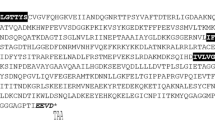Summary
Fifth instar larvae of the tobacco hornworm,Manduca sexta, tolerate 1-h exposures to temperatures as high as 42°C. Above 42°C, survival declines rapidly to 18% at 44°C and 0% at 48°C. As in other insects, the heat-shock response ofManduca sexta involves the induction of synthesis of heat-shock proteins very similar in size to theDrosophila heat-shock proteins (84, 73, 71, 27, 25, 23, and 22 kd). In the epidermis, heat-shock protein synthesis peaks at 42°C, correlating with the heat sensitivity of both the tissue itself and the intact larva. Some heat-shock proteins have different isoelectric forms depending on tissue. Also, the heat-shock proteins are synthesized over a wider range of temperatures in the imaginal discs and the fat body as compared to the epidermis. In contrast to dipteran insects,Manduca sexta does not exhibit a strong repression of non-heat-shock protein synthesis under tolerable conditions.
Similar content being viewed by others
Abbreviations
- TCA :
-
trichloroacetic acid
- PAGE :
-
polyacrylamide gel electrophoresis
- AZT :
-
arbitrary Zeitgeber time
- kd :
-
kilodaltons
References
Ames GF (1974) Resolution of bacterial proteins by polyacrylamide gel electrophoresis on slabs. J Biol Chem 249:634–644
Anonymous (1988) US National Climatic Data Center. Climatological data: North Carolina 93.7:3–5
Baldaia L, Maisonhaute C, Porcheron P, Best-Belpomme M (1987) Effect of heat shock on protein synthesis inLocusta migratoria epidermis. Arch Insect Biochem Physiol 4:225–231
Bearden JC Jr (1978) Quantitiation of submicrogram quantities of protein by an improved protein-dye binding assay. Biochim Biophys Acta 533:525–529
Bell RA, Joachim FG (1976) Techniques for rearing laboratory colonies of tobacco hornoworms and pink bolloworms. Ann Entomol Soc Amer 69:365–373
Bultmann H (1986) Heat shock responses in polytene footpad cells ofSarcophaga bullata. Chromosoma 93:347–357
Carvalho MGC, Rebello MA (1987) Induction of heat shock proteins during the growth ofAedes albopictus cells. Insect Biochem 17:199–206
Casey TM (1976) Activity patterns, body temperature and thermal ecology in two desert caterpillars (Lepidoptera: Sphingidae). Ecology 57:485–497
Casey TM (1977) Physiological responses to temperature of caterpillars of a desert population ofManduca sexta (Lepidopt.: Sphingidae). Comp Biochem Physiol 57A:53–58
Dean RL, Atkinson GB (1982) The acquisition of thermotolerance in larvae ofCalpodes ethlius (Lepidoptera) and the in situ and in vitro synthesis of heat-shock proteins. Can J Biochem Cell Biol 61:472–479
Ingolia TD, Craig EA (1982)Drosophila gene related to the major heat shock-induced gene is transcribed at normal temperatures and not induced by heat shock. Proc Natl Acad Sci USA 79:525–529
Jones P (1980) Analysis of radiolabeled lymphocyte proteins by one and two dimensional polyacrylamide gel electrophoresis. In: Mishell BB, Shiigi SM (eds) Selected methods in cellular immunology. Freeman, San Francisco, pp 398–440
Kiely ML, Riddiford LM (1985) Temporal programming of epidermal cell protein synthesis during the larval-pupal transformation ofManduca sexta. Wilhelm Roux's Arch Dev Biol 194:325–335
Laskey RA, Mills AD (1975) Quantitative film detection of3H and14C in polyacrylamide gels by fluorography. Eur J Biochem 56:335–341
Lindquist S (1980) Varying patterns of protein synthesis inDrosophila during heat shock: implications for regulation. Devel Biol 77:463–479
Lindquist S (1981) Regulation of protein synthesis inDrosophila during heat shock. Nature 293:311–314
Lindquist S (1986) The heat-shock response. Ann Rev Biochem 55:1151–1191
Mitchell HK, Petersen NS, Buzin CK (1985) Self-degradation of heat-shock proteins. Proc Natl Acad Sci USA 82:4969–4973
Nover L, Hellmund D, Neumann D, Scharf K-D, Serfling E (1984) The heat-shock response of eukaryotic cells. Springer, Berlin Heidelberg New York
Pelham HRB (1988) Coming in from the cold. Nature 332:776–777
Petersen NS, Mitchell HK (1985) Heat-shock proteins. In: Kerkut GA, Gilbert LI (eds) Comprehensive insect physiology, Biochemistry, and pharmacology, vol. 10. Pergamon Press, New York, pp 347–365
Riddiford LM (1976) Hormonal control of insect epidermal cell commitment in vitro. Nature 259:115–117
Riddiford LM (1978) Ecdysone-induced change in cellular commitment of the epidermis of the tobacco hornworm,Manduca sexta, at the initiation of metamorphosis. Gen Comp Endocr 34:438–446
Ruder GK, Ovsenek N, Heikkila JJ, Downer RGH (1989) Examination of heat-shock gene expression in nerve cord isolated from heat-stressed American cockroach,Periplaneta americana. Biochem Cell Biol 67:168–172
Schlesinger MJ, Ashburner M, Tissieres A (1982) Heat shock: from bacteria to man. Cold Springer Harbor Laboratory, Cold Spring Harbor
Stephanou G (1987) On the control of heat-shock protein synthesis inDrosophila melanogaster andCeratitis capitata. Insect Biochem 17:597–602
Stephanou G, Alahiotis SN, Marmaras VJ, Christodoulou C (1983) Heat-shock response inCeratitis capitata. Comp Biochem Physiol 74B:425–432
Truman JW (1972) Physiology of insect rhythms, I. Circadian organization of the endocrine events underlying the moulting cycle of larval tobacco hornworms. J Exp Biol 57:805–820
Vincent M, Tanguay RM (1979) Heat-shock induced proteins present in the cell nucleus ofChironomus tentans salivary gland. Nature 281:501–503
Webb BA, Riddiford LM (1988) Synthesis of two storage proteins during larval development of the tobacco hornworm,Manduca sexta. Devel Biol 130:671–681
Whyard S, Wyatt GR, Walker VK (1986) The heat-shock response inLocusta migratoria. J Comp Physiol B 156:813–817
Wolfgang WJ, Riddiford LM (1986) Larval cuticular morphogenesis in the tobacco hornworm,Manduca sexta, and its hormonal regulation. Devel Biol 113:305–316
Author information
Authors and Affiliations
Rights and permissions
About this article
Cite this article
Fittinghoff, C.M., Riddiford, L.M. Heat sensitivity and protein synthesis during heat-shock in the tobacco hornworm,Manduca sexta . J Comp Physiol B 160, 349–356 (1990). https://doi.org/10.1007/BF01075665
Accepted:
Issue Date:
DOI: https://doi.org/10.1007/BF01075665




